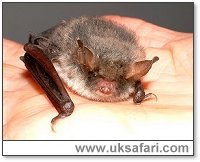
|

|
|
 Sent
to you Sent
to you
by e-mail
|
|
Simply
enter your details and hit the send button
more
info |
|


Click Here

Links
Advertise
Terms of Use
Contributors
About Us
Contact Us
|
 |
Go back
 | Bookmark
| Bookmark
 | Print Page
| Print Page  | E-Mail Us
| E-Mail Us 
 
 Photo: G. Bradley
Photo: G. Bradley
|
|
UK
Safari Tip:
Find out which species of bat are living in your area. Tune into their
ultrasonic calls with a bat detector from the Nature Shop - click
here
|
|
Latin name: Myotis nattereri
Size: Wingspan approximately 25 to 33cms. Head and body around 45mms.
Distribution: Found throughout the UK.
Months seen: April to October.
Food: Flies, moths, midges and spiders.
Habitat: Roosts in trees and old buildings.
Echolocation Frequency: 45 - 50 kHz
Special features: A medium sized bat. Natterer's can be recognised by their shaggy fur which looks as if it has been highlighted. It is grey on the back and white on the front. They also have a row of short, bristly hairs along the edge of the tail membrane.
The nose is pink and the ears, which point outwards, have a kink in them. The narrow, pointed tragus is around two thirds the length of the ears.
This bat gets its name from the nineteenth century Austrian naturalist who discovered it.

What is a bat?
What does a bat sound like?
UK Safari Bat Section
What is a tragus?
|
 |

|